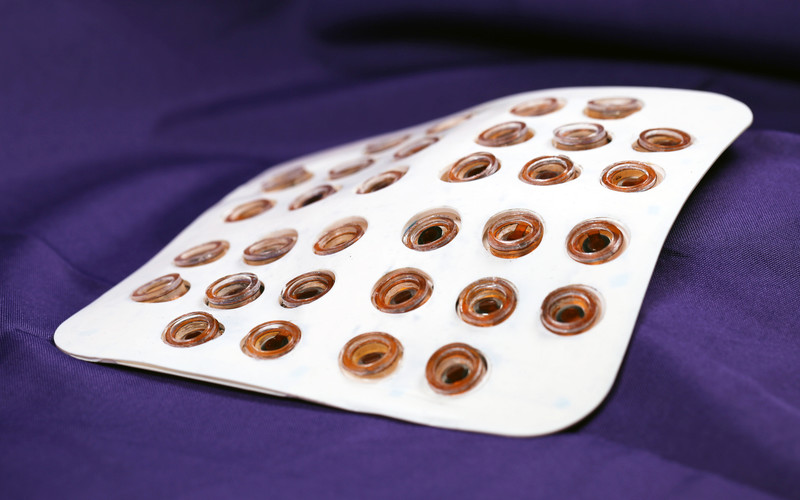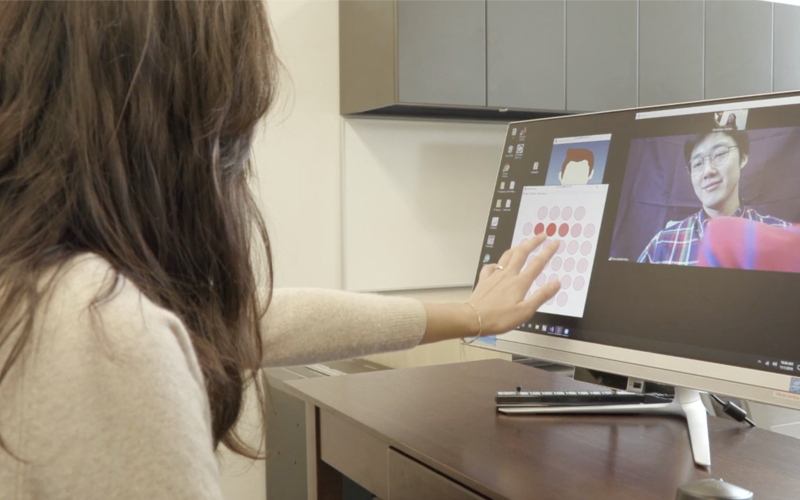In a world of remote learning and social distancing, tactile sensations are sorely missing — but perhaps not for much longer. At Northwestern University, researchers have created an epidermal virtual reality device that mimics the sensation of human touch. Featuring an array of tiny, vibrating, individually programmable components called actuators, the device adheres to the user’s skin like a Band-Aid using a silicon polymer material.
“Imagine the little buzzer in your Apple Watch,” explains John Rogers, who worked on the technology with Yonggang Huang. “It’s like putting Apple Watches all over your body, but not in that rigid form. Instead it’s in a thin, skinlike form factor, so what you feel is like a gentle touch.”
Rogers and Huang, both engineering professors at Northwestern University, originally created the epidermal VR device to monitor the progress of speech patterns and swallowing in stroke survivors. The device not only sent information back to the patient’s rehabilitation specialist, but also alerted the patient to irregular swallowing or speaking patterns through tactile feedback.
The researchers then realized that if the actuators were programmable, “you could create an immersive experience that would have relevance to virtual reality and add touch-level engagement to that broader experience,” Rogers says.
VR Opens the Door for Personal Interaction, Encouragement
The potential for epidermal VR is enormous. The researchers are testing the device with amputees using prosthetic hands. However, for K–12 stakeholders, this innovative, easy-to-use tech device could have a powerful effect on remote interactions between teachers and young students.
Teachers could potentially use epidermal VR to offer encouragement and positive reinforcement to their far-flung students with a literal pat on the back. “It enhances personal interaction in a way that just cannot be replicated by the image on a screen or by the sound coming out of the speakers,” Rogers says.
DIVE DEEPER: See how other K–12 schools are innovating with emerging technologies.
The booming world of esports is another possible application, but the material could also be used for instructing and training students in physical sports or music. By helping students hold their bodies in the correct posture and orientation, a remote teacher could guide a student through different processes that typically require physical or mechanical manipulation.
Adding a tactile element to a virtual field trip would create a more realistic and memorable experience. For special-needs students who need practice with unfamiliar settings and scenarios, epidermal VR could prove useful for reducing anxiety.
Devices Function as a Programmable Second Skin
The device, which is expected to be ready for manufacturing in a couple years, can be tailored to any size and shape. And, to more closely mimic the sensation of warmth from another person’s fingers, the team wants the device to be able to heat and cool the skin.
The device can be placed anywhere on the body and repositioned as necessary. Although, battery free, it currently weighs just a few grams per 10 square centimeters, Rogers says the technology will become thinner and lighter as it’s developed further. Ultimately, users will be able to wear the device like a fully programmable second skin. “It’s completely feasible to have full-body engagement,” Rogers says.
A family uses the epidermal VR device while on a video call.
Northwestern University
"device" - Google News
June 01, 2021 at 11:28PM
https://ift.tt/3fFwNZh
VR-Compatible Device Mimics Human Touch - EdTech Magazine: Focus on K-12
"device" - Google News
https://ift.tt/2KSbrrl
https://ift.tt/2YsSbsy
Bagikan Berita Ini























0 Response to "VR-Compatible Device Mimics Human Touch - EdTech Magazine: Focus on K-12"
Post a Comment